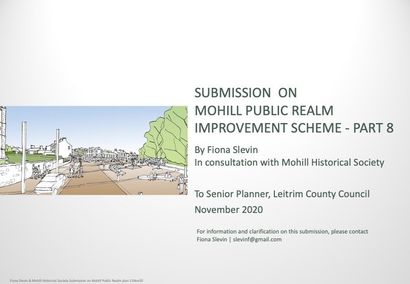Mohill Public Realm Improvement Scheme 2020
About the submission (from introduction)
The Public Realm Improvement Scheme is a positive development for the town. We welcome all efforts to improve attractiveness, enterprise, access and community engagement – including many of the ideas in the proposed plan.
However, we believe that the proposed plan is a missed opportunity to honour our past, take pride in our present, and demonstrate belief in our future.
This submission is grounded in the knowledge of Mohill’s history and resilience through more than 15 centuries. At various times, Mohill has been deprived or thrived, but through it all, it survived. This submission, and the observations and recommendations contained in it, are driven by the need to ensure our town’s continued survival.
Mohill’s history is Ireland’s history
Mohill’s story starts with the establishment of a monastery c500 by St Manchán, a major figure of monastic Ireland*.
The first major settlement by Conmaicne Réin lasted nearly 1,000 years until the 1600s. This unbroken experience of Gaelic life differentiated Mohill from the many parts of Ireland that experienced Viking invasion and Norman occupation. The Gaelic lordships disappeared with the Plantation of Leitrim in 1620, but their influences can be seen on today’s geography, society and culture: parish boundaries, family names and even discernible differences in accent, remarkably reflect old clann borders that should have disappeared 400 years ago.
In the modern era, Mohill’s experience of the Famine and landlordism under Lord Leitrim was an extreme example of Ireland’s rural history in the 19th century, including depopulation, emigration, post-Famine recovery, and – in the 20th century – economic decline.
Download the full submission here >>>>


